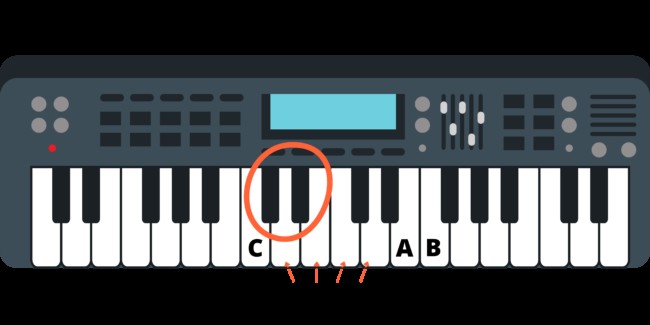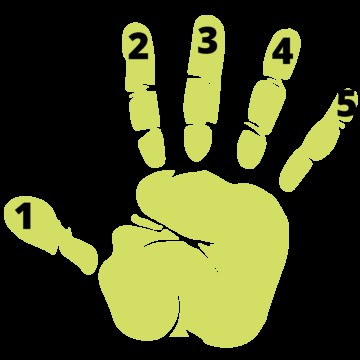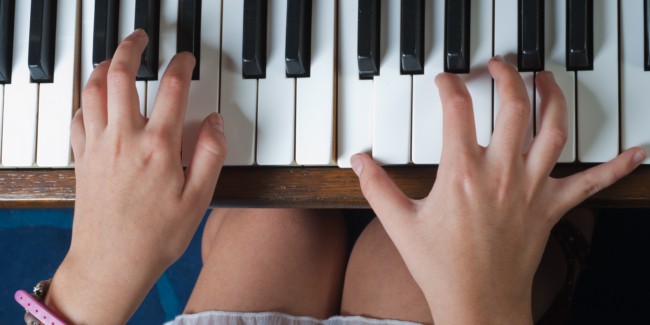Learning how to play a keyboard can be an enjoyable and rewarding experience. At LEARNS.EDU.VN, we provide you with a structured approach to master this skill, offering step-by-step guidance and practical exercises. Whether you’re a complete beginner or have some musical experience, LEARNS.EDU.VN provides resources to help you develop your keyboard skills. Explore our platform for more in-depth lessons on musical notation, finger dexterity, and effective practice techniques.
1. Understanding Keyboard Basics
1.1. Identifying the Keys
The foundation of playing the keyboard is knowing the names of the keys. Each key corresponds to a specific note, labeled with letters A through G. Music sheets and charts use these notes to instruct you on what to play.
- White Keys: Represent whole notes.
- Black Keys: Represent semitones (sharps and flats) and are located between some of the white keys.
An octave includes seven white keys and five black keys arranged in groups of two and three.
1.2. How to Locate Notes
Start by identifying groups of two black keys. The white key to the left of this group is always C. From there, you can find the other notes:
- Locate a group of two black keys
- The white key to the left is C
- The next four keys to the right are D, E, F, and G
- Followed by A and B
- The sequence repeats
As you move right, the pitch increases; moving left decreases it. The C near the middle of the keyboard is called Middle C.
1.3. The Importance of Labeling Keys
Labeling keys is a practical step for beginners. This helps in memorizing the note positions and accelerates learning. Consider using removable labels initially, which can be taken off as you become more comfortable with the keyboard layout.
2. Mastering Chords and Scales
2.1. Understanding Scales
Scales are sequences of notes that define the tonality of a piece. They consist of whole and half steps, with major scales being the most common. Here are a few major scales:
- A Major: A, B, C#, D, E, F#, G#, A
- C Major: C, D, E, F, G, A, B, C
- G Major: G, A, B, C, D, E, F#, G
2.2. Constructing Chords
Chords are formed when two or more notes are played simultaneously. A triad consists of three notes:
- Root Note: The first note of the scale (defines the chord’s name).
- Third Note: The third note of the scale (for major chords).
- Fifth Note: The fifth note of the scale.
Different types of chords, such as major and minor chords, follow specific construction rules. A minor chord is created by lowering the third note of a major chord by a half-step.
2.3. Common Chords for Beginners
Here are some common major and minor chords:
| Chord | Notes |
|---|---|
| C Major | C, E, G |
| G Major | G, B, D |
| A Minor | A, C, E |
| D Minor | D, F, A |
| E Minor | E, G, B |




2.4. Using Chord Sheets
Chord sheets provide visual representations or notations that indicate which chords to play. Often, the left hand plays chords while the right hand plays the melody.
3. Optimizing Hand and Finger Placement
3.1. The Significance of Correct Hand Position
Proper hand placement is crucial for efficient and comfortable playing. Correct positioning allows you to reach notes easily and facilitates the use of specific fingerings indicated in sheet music.
3.2. Numbering Fingers
Number your fingers from 1 to 5, starting with your thumb. This numbering is standard in keyboard exercises and sheet music.
- 1: Thumb
- 2: Index Finger
- 3: Middle Finger
- 4: Ring Finger
- 5: Pinky Finger
3.3. Exercise 1: Finger Exercises on Middle C
- Place your right thumb (finger 1) on Middle C.
- Play C with finger 1, D with finger 2, E with finger 3, F with finger 4, and G with finger 5.
- Vocalize the note names as you play to aid memorization.
- Repeat the sequence backward, returning to Middle C.
- Practice this exercise with your left hand, moving downwards from Middle C.
3.4. Exercise 2: Scale Practice
Practice playing scales to improve finger dexterity and coordination. Using the C major scale (C, D, E, F, G, A, B, C), use the following fingering pattern with your right hand:
1 – 2 – 3 – 1 – 2 – 3 – 4 – 5
Your thumb will go under as you play the fourth note in the sequence. Practice this pattern going both forwards and backward.
3.5. Key Considerations for Proper Form
- Curved Fingers: Maintain a natural curve in your fingers.
- Relaxed Wrist: Keep your wrist relaxed and flexible.
- Alignment: Align your pinkies with your wrists and elbows.
- Relaxed Shoulders: Avoid tension in your shoulders.
4. Enhancing Hand Coordination
4.1. Developing Independent Hand Movement
A key aspect of keyboard proficiency is the ability to perform different actions with each hand simultaneously. This requires developing independence between your left and right hands.
4.2. Exercise: Opposite Direction Scales
Play a C major scale with both hands, but in opposite directions. As your right hand ascends the scale, your left hand descends, both returning to Middle C.
4.3. Exercise: Same Direction Scales
- Start with your right thumb on Middle C and your left pinky an octave lower.
- Play the C major scale with your right hand as usual.
- The fingering sequence for your left hand will be 5 – 4 – 3 – 2 – 1 – 3 – 2 – 1, ending with the left thumb on Middle C.
- Reverse the process.
5. Selecting the Right Keyboard
5.1. Keyboard Types
- Digital Pianos: Designed to mimic the sound and feel of an acoustic piano. They often feature weighted keys, providing a more realistic playing experience.
- Synthesizers: Offer a wide range of sounds and effects. Synthesizers are versatile instruments suitable for various musical genres.
- Portable Keyboards: Lightweight and easy to transport. They are ideal for beginners and musicians who need a practice instrument on the go.
5.2. Key Features to Consider
- Key Action: Weighted, semi-weighted, or synth-action keys affect the playing experience. Weighted keys closely resemble the feel of an acoustic piano.
- Number of Keys: 88 keys are standard for playing classical pieces, while 61 or 76 keys may suffice for other genres.
- Sound Quality: The quality of the built-in sounds can significantly impact your enjoyment of playing.
- Connectivity: USB and MIDI ports allow you to connect the keyboard to computers and other devices.
5.3. Recommended Keyboards for Beginners
- Yamaha PSR-E363: A portable keyboard with a wide range of sounds and features.
- Casio CTK-3500: An affordable option with built-in lessons and practice tools.
- Roland Juno-DS61: A versatile synthesizer suitable for various musical styles.
6. Effective Practice Techniques
6.1. Setting Goals
Establish clear, achievable goals to stay motivated. Whether it’s mastering a specific song or improving your scale-playing speed, goals provide direction and a sense of accomplishment.
6.2. Consistent Practice Schedule
Regular practice is key to improving your keyboard skills. Aim for short, frequent sessions rather than long, infrequent ones. Even 15-30 minutes of daily practice can yield significant results.
6.3. Focus on Fundamentals
Ensure a strong grasp of basic concepts before moving on to more complex material. This includes understanding music theory, mastering scales and chords, and developing proper hand and finger positioning.
6.4. Use a Metronome
A metronome helps you maintain a consistent tempo and improve your timing. Start with slow tempos and gradually increase the speed as you become more comfortable.
6.5. Record Yourself
Recording your practice sessions allows you to identify areas for improvement. Listen critically to your playing and note any mistakes or inconsistencies.
6.6. Break Down Complex Pieces
When learning a challenging piece, break it down into smaller sections. Practice each section separately before putting them together.
6.7. Vary Your Practice Routine
Avoid monotony by incorporating different exercises and pieces into your practice routine. This keeps your practice sessions engaging and helps you develop a wider range of skills.
6.8. The Role of Deliberate Practice
Deliberate practice involves focusing on specific areas for improvement and actively seeking feedback. This method is more effective than simply playing through pieces without focused attention. According to research from Florida State University, deliberate practice can lead to a significant increase in skills.
7. Resources for Learning Keyboard
7.1. Online Courses
Online platforms offer structured keyboard lessons for all skill levels. These courses often include video tutorials, interactive exercises, and personalized feedback.
- LEARNS.EDU.VN: Comprehensive courses designed to take you from beginner to advanced.
- Coursera: Offers courses from top universities and music schools.
- Udemy: Features a wide variety of keyboard and piano courses.
- Skillshare: Provides creative courses, including music lessons.
7.2. Mobile Apps
Mobile apps make it convenient to practice keyboard anywhere. Many apps offer interactive lessons, song libraries, and progress tracking.
- Simply Piano: An app that provides step-by-step lessons and real-time feedback.
- Flowkey: Features a vast library of songs and interactive tutorials.
- Yousician: Offers lessons for various instruments, including keyboard.
7.3. Books and Sheet Music
Traditional books and sheet music provide a wealth of learning material. Look for beginner-friendly books that cover music theory, technique, and repertoire.
- Alfred’s Basic Adult Piano Course: A comprehensive course for adult beginners.
- Hal Leonard Piano Method: A step-by-step method for learning piano.
- Faber Piano Adventures: A popular series for young learners.
7.4. YouTube Channels
YouTube is a valuable resource for free keyboard lessons and tutorials. Many experienced musicians and educators share their knowledge on YouTube.
- PianoLessons.com: Offers a wide range of lessons for all skill levels.
- Lypur: Provides tutorials on music theory and piano technique.
- Josh Wright Piano TV: Features lessons and performances by a concert pianist.
7.5. Private Teachers
Working with a private teacher can provide personalized instruction and feedback. A teacher can assess your strengths and weaknesses and tailor lessons to your specific needs.
8. Music Theory Basics
8.1. Understanding Notes and Rhythms
Music theory provides the framework for understanding how music works. This includes learning about notes, rhythms, and their relationships.
- Notes: Represent the pitch of a sound.
- Rhythms: Determine the duration of notes and the timing of musical events.
8.2. Key Signatures and Time Signatures
Key signatures indicate the key of a piece of music. They tell you which notes are consistently sharp or flat throughout the piece. Time signatures indicate the number of beats in each measure and the type of note that receives one beat.
8.3. Intervals and Chords
Intervals are the distance between two notes. Chords are combinations of notes played together. Understanding intervals and chords is essential for playing and composing music.
8.4. Chord Progressions
Chord progressions are sequences of chords that create a musical structure. Learning common chord progressions can help you understand how songs are constructed and how to create your own music.
9. Overcoming Challenges
9.1. Staying Motivated
Learning keyboard can be challenging, and it’s normal to experience periods of frustration. Find ways to stay motivated, such as setting goals, joining a music community, or performing for others.
9.2. Dealing with Plateaus
Plateaus occur when you stop seeing progress despite consistent practice. To overcome plateaus, try new exercises, seek feedback from a teacher, or explore different musical styles.
9.3. Managing Performance Anxiety
Performance anxiety is common among musicians. To manage anxiety, practice performing in front of others, use relaxation techniques, and focus on enjoying the music.
9.4. Finding Time to Practice
Finding time to practice can be difficult, especially with busy schedules. Prioritize practice by scheduling it like any other important appointment and finding small pockets of time throughout the day.
10. Exploring Musical Styles
10.1. Classical Music
Classical music offers a rich repertoire for keyboard players. Explore composers like Bach, Mozart, and Beethoven to develop your technique and musicality.
10.2. Pop Music
Pop music provides opportunities to learn about chord progressions, rhythms, and song structures. Many pop songs are accessible for beginner keyboard players.
10.3. Jazz Music
Jazz music emphasizes improvisation and creativity. Learning jazz standards and improvisational techniques can expand your musical horizons.
10.4. Blues Music
Blues music features distinctive chord progressions and scales. Learning blues can enhance your understanding of rhythm and expression.
10.5. Electronic Music
Electronic music offers unique opportunities to experiment with sounds and effects. Synthesizers and keyboards are essential tools for creating electronic music.
11. Leveraging Technology
11.1. MIDI Keyboards
MIDI keyboards allow you to control virtual instruments and software synthesizers. They are versatile tools for music production and performance.
11.2. Music Production Software (DAWs)
Digital Audio Workstations (DAWs) are software programs used for recording, editing, and mixing music. Popular DAWs include Ableton Live, Logic Pro X, and Pro Tools.
11.3. Virtual Instruments
Virtual instruments are software programs that emulate the sounds of real instruments. They offer a wide range of sounds for use in music production.
11.4. Online Collaboration Tools
Online collaboration tools enable musicians to work together remotely. These tools facilitate sharing ideas, recordings, and feedback.
12. Advanced Techniques
12.1. Improvisation
Improvisation involves creating music spontaneously. Learning improvisational techniques can enhance your creativity and musical expression.
12.2. Sight-Reading
Sight-reading is the ability to play music accurately at first sight. Developing sight-reading skills can expand your repertoire and make you a more versatile musician.
12.3. Composition
Composition involves creating your own music. Learning about composition can help you understand musical structures and express your ideas creatively.
12.4. Arranging
Arranging involves adapting existing music for different instruments or ensembles. Learning about arranging can broaden your musical skills and provide new creative outlets.
13. Performance Tips
13.1. Stage Presence
Stage presence involves engaging the audience and communicating your musical expression. Practice your stage presence to create a memorable performance.
13.2. Microphone Technique
Proper microphone technique is essential for vocal and instrumental performances. Learn how to position the microphone and control your dynamics.
13.3. Soundcheck
A soundcheck allows you to adjust the sound levels and ensure that everything is working correctly. Always perform a soundcheck before a performance.
13.4. Handling Mistakes
Everyone makes mistakes, especially during performances. Learn how to recover gracefully and keep the music flowing.
14. The Benefits of Learning Keyboard
14.1. Cognitive Benefits
Learning keyboard can improve memory, attention, and problem-solving skills. Playing music engages multiple areas of the brain and promotes cognitive development.
14.2. Emotional Benefits
Playing keyboard can reduce stress, improve mood, and enhance self-expression. Music provides a creative outlet for emotions and can promote emotional well-being.
14.3. Social Benefits
Learning keyboard can connect you with other musicians and music lovers. Joining a band or music community can provide social support and opportunities for collaboration.
14.4. Career Opportunities
Keyboard skills can open doors to various career opportunities, including performing, teaching, composing, and music production.
15. Connecting with the Music Community
15.1. Joining a Band
Joining a band provides opportunities to collaborate with other musicians and perform for audiences. Playing in a band can enhance your musical skills and provide social connections.
15.2. Attending Concerts
Attending concerts allows you to experience live music and connect with other music lovers. Watching live performances can inspire you and provide new ideas for your own playing.
15.3. Participating in Workshops
Workshops offer opportunities to learn from experienced musicians and develop your skills. Participating in workshops can provide valuable insights and networking opportunities.
15.4. Online Forums
Online forums provide platforms for musicians to share ideas, ask questions, and connect with others. Participating in online forums can expand your knowledge and provide support.
16. Continued Learning at LEARNS.EDU.VN
16.1. Explore Advanced Courses
LEARNS.EDU.VN offers a range of advanced courses designed to help you deepen your keyboard skills. These courses cover advanced music theory, technique, and repertoire.
16.2. Personalized Learning Paths
Our platform provides personalized learning paths tailored to your specific goals and skill level. These paths guide you through the learning process and ensure that you’re making progress.
16.3. Expert Instructors
LEARNS.EDU.VN features expert instructors with years of experience in music education. Our instructors provide personalized feedback and support to help you succeed.
16.4. Community Support
Join our community of learners to connect with other musicians and share your experiences. Our community provides a supportive environment for learning and growth.
17. Final Thoughts
Learning to play the keyboard is a journey filled with challenges and rewards. By following a structured approach, practicing consistently, and leveraging available resources, you can achieve your musical goals. Remember to stay patient, persistent, and passionate about music.
Ready to embark on your musical journey? Visit LEARNS.EDU.VN today to explore our comprehensive courses and resources. Let us help you unlock your musical potential and achieve your dreams. With step-by-step guidance, expert instructors, and a supportive community, LEARNS.EDU.VN is your partner in music education. Contact us at 123 Education Way, Learnville, CA 90210, United States. Whatsapp: +1 555-555-1212. Visit our website at LEARNS.EDU.VN to get started!
FAQs
How Can I Teach Myself to Play Keyboard?
To teach yourself to play keyboard, start by familiarizing yourself with the instrument and learning the names of the keys. Practice scales regularly, focus on proper posture and hand position, and use online resources like LEARNS.EDU.VN for structured lessons. Consistent practice and patience are key.
What Should a Beginner in Piano Learn?
A beginner in piano should learn the basics, such as identifying notes, understanding scales and chords, and proper hand positions. Labeling keys, practicing finger numbering, and mastering the C-major scale are essential first steps. Resources like LEARNS.EDU.VN can provide step-by-step guidance.
Is Piano Hard to Learn?
Learning piano requires commitment and consistent practice. While it can be challenging, daily practice and a structured approach can make the process easier. Over time, you’ll become more familiar with hand positions, key labels, and other vital factors, leading to faster progress.
How Long Does it Take to Learn Keyboard?
The time it takes to learn keyboard varies depending on your goals, practice habits, and natural aptitude. With consistent practice, you can learn basic skills within a few months, but mastering the instrument can take years of dedicated effort.
What is the Best Age to Learn Keyboard?
There is no best age to learn keyboard. While children can benefit from early music education, adults can also learn keyboard successfully. Motivation, dedication, and consistent practice are more important than age.
Do I Need a Teacher to Learn Keyboard?
While a teacher can provide personalized instruction and feedback, it is possible to learn keyboard on your own using online resources, books, and apps. A teacher can help you avoid bad habits and accelerate your progress, but self-learning is also a viable option.
How Often Should I Practice Keyboard?
Aim for daily practice sessions of at least 15-30 minutes. Consistent, short practice sessions are more effective than infrequent, long sessions. Regular practice helps you reinforce what you’ve learned and make steady progress.
What are Some Good Warm-Up Exercises for Keyboard?
Good warm-up exercises for keyboard include scales, arpeggios, and finger exercises. These exercises help improve finger dexterity, coordination, and muscle memory. Start with slow tempos and gradually increase the speed as you become more comfortable.
How Can I Improve My Sight-Reading Skills?
To improve your sight-reading skills, practice reading new music regularly. Start with simple pieces and gradually increase the difficulty. Focus on recognizing patterns and intervals, and try to keep your eyes moving ahead of your fingers.
What are Some Common Mistakes to Avoid When Learning Keyboard?
Common mistakes to avoid when learning keyboard include poor posture, incorrect hand position, inconsistent practice, and neglecting music theory. Focus on developing good habits from the beginning and seek feedback from a teacher or experienced musician to correct any errors.
How to Find the Best Online Keyboard Lessons?
Finding the best online keyboard lessons involves looking for structured courses, expert instructors, personalized feedback, and a supportive community. Platforms like LEARNS.EDU.VN offer these features, providing a comprehensive learning experience. Additionally, check reviews and testimonials to ensure the quality of the lessons.
What’s the Difference Between a Keyboard and a Piano?
The main differences between a keyboard and a piano lie in their action, sound, and portability. Pianos have weighted keys and produce sound acoustically, while keyboards often have lighter, synth-action keys and use electronic sound generation. Keyboards are also generally more portable and versatile due to their digital capabilities.
How Can I Improve My Hand Coordination on the Keyboard?
Improving hand coordination on the keyboard involves practicing exercises that require each hand to perform different tasks simultaneously. Scales in contrary motion, playing chords with the left hand while improvising a melody with the right, and using resources like LEARNS.EDU.VN for specific coordination drills can be highly effective.
What Resources Does LEARNS.EDU.VN Offer for Learning the Keyboard?
learns.edu.vn offers a wide range of resources for learning the keyboard, including structured online courses, personalized learning paths, expert instructors, and a supportive community. Our courses cover everything from beginner basics to advanced techniques, providing a comprehensive learning experience tailored to your individual goals and skill level.
These FAQs address common questions and concerns related to learning the keyboard, providing valuable information and resources for aspiring musicians.
